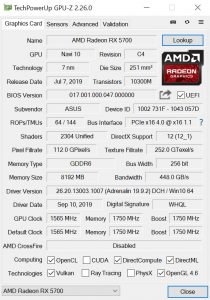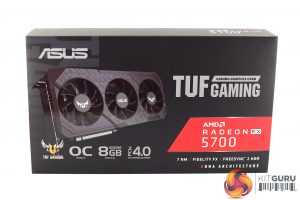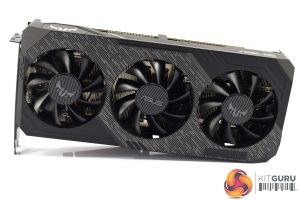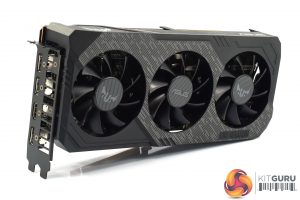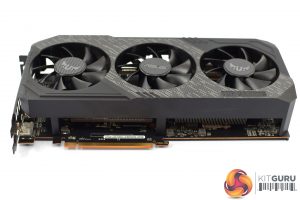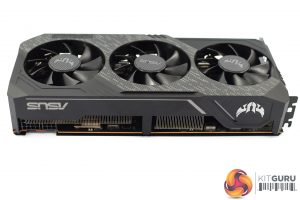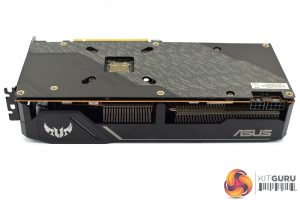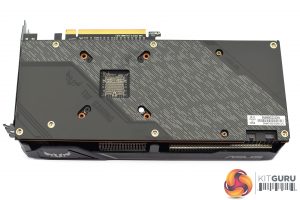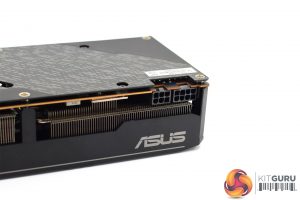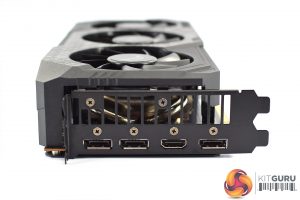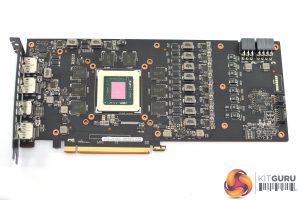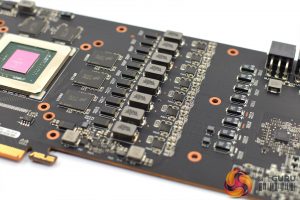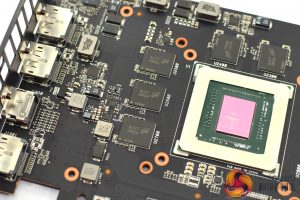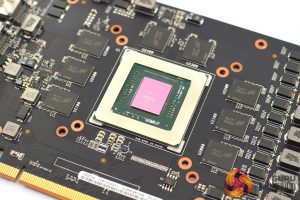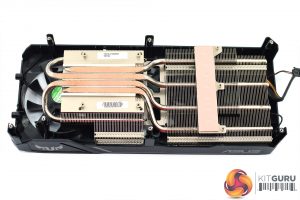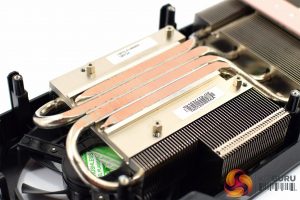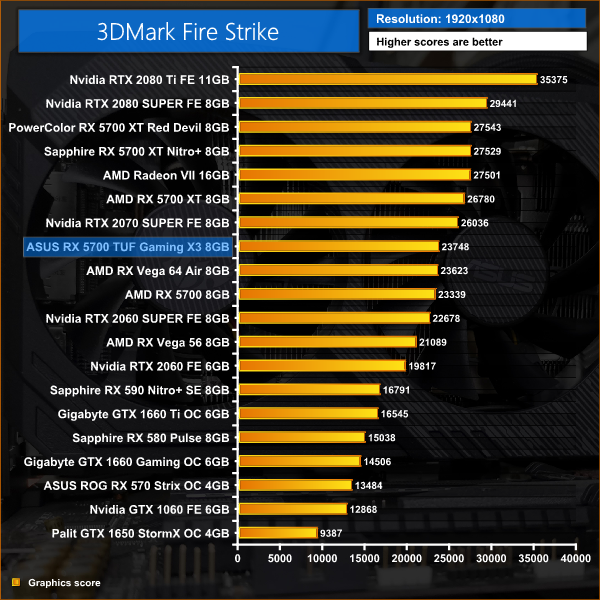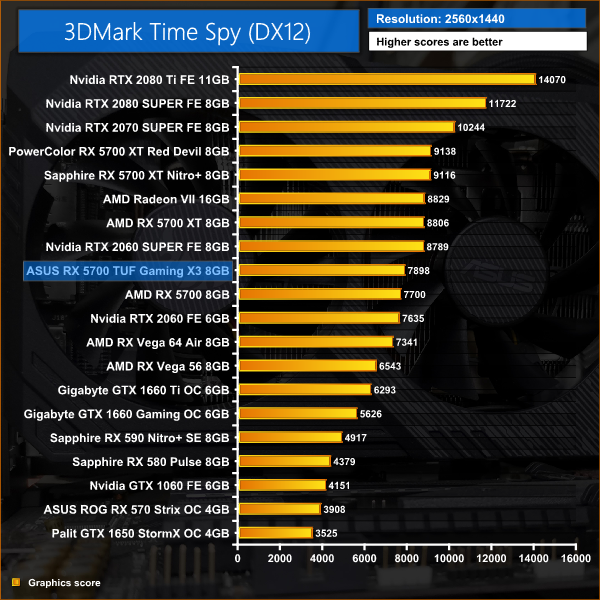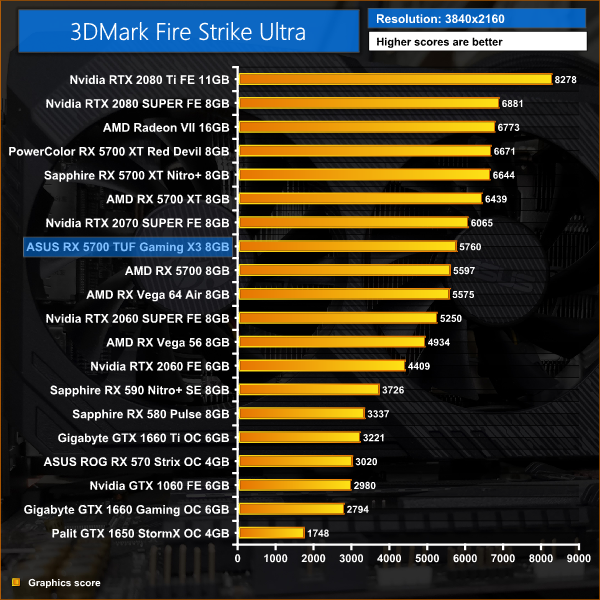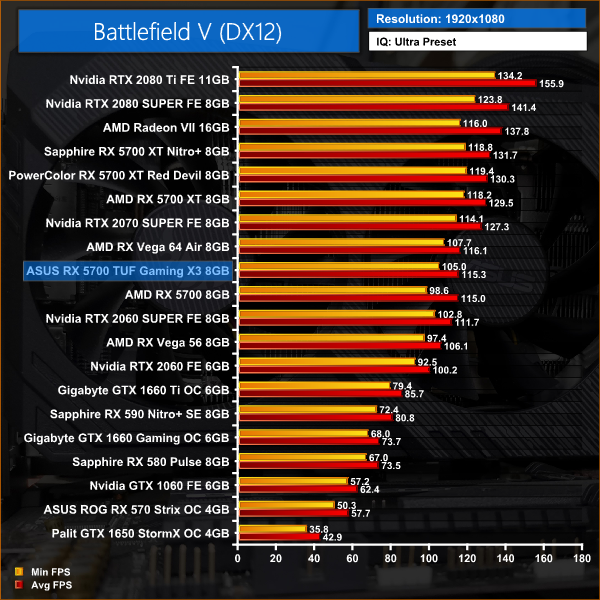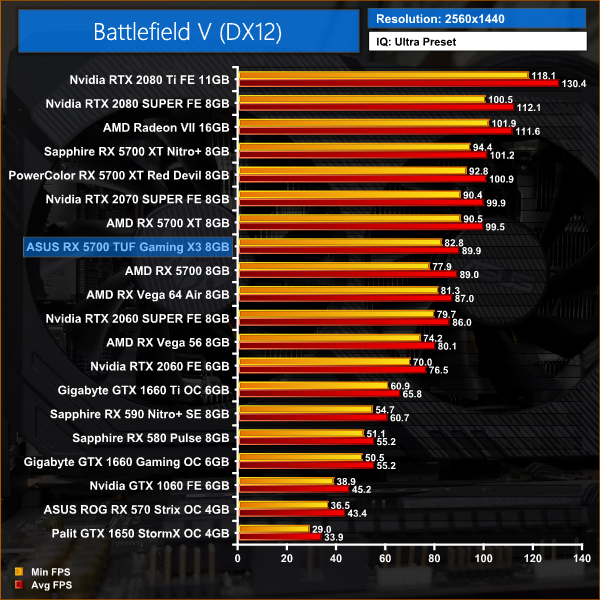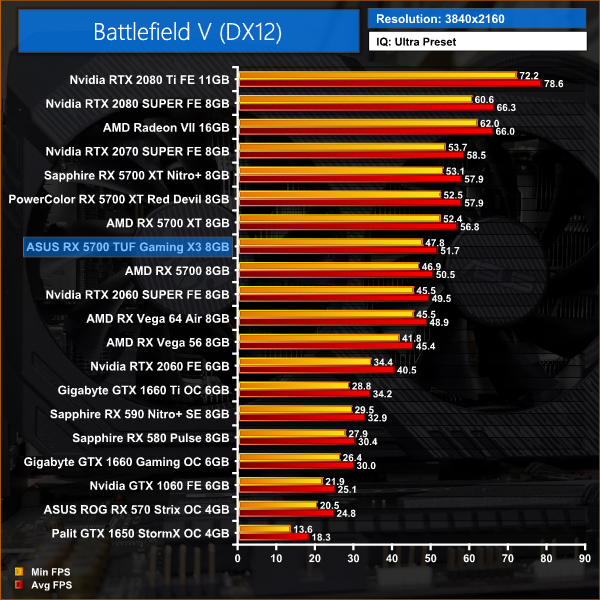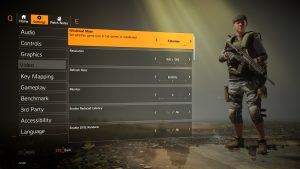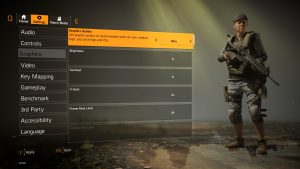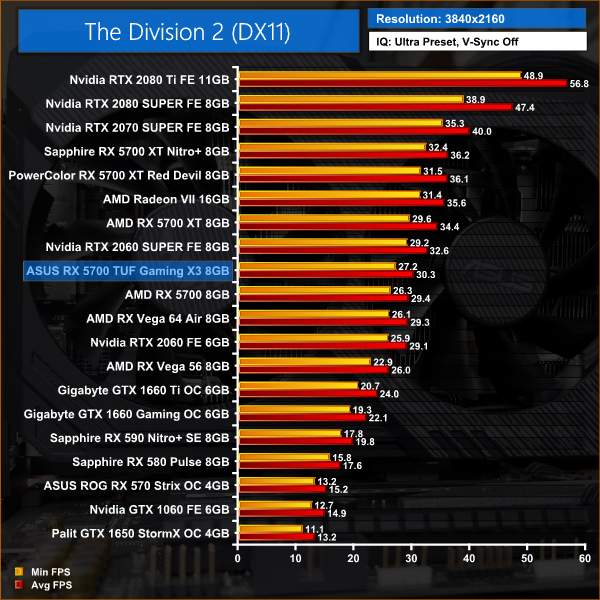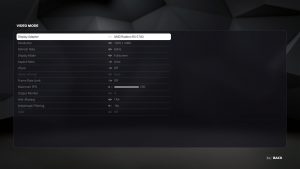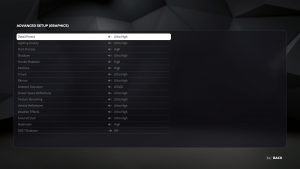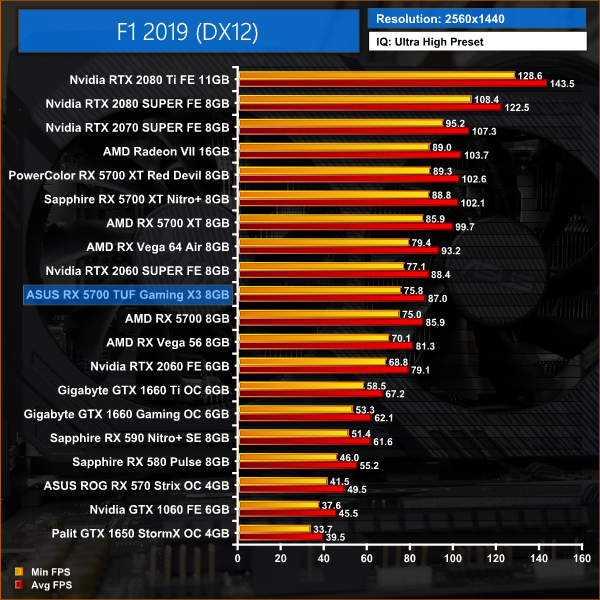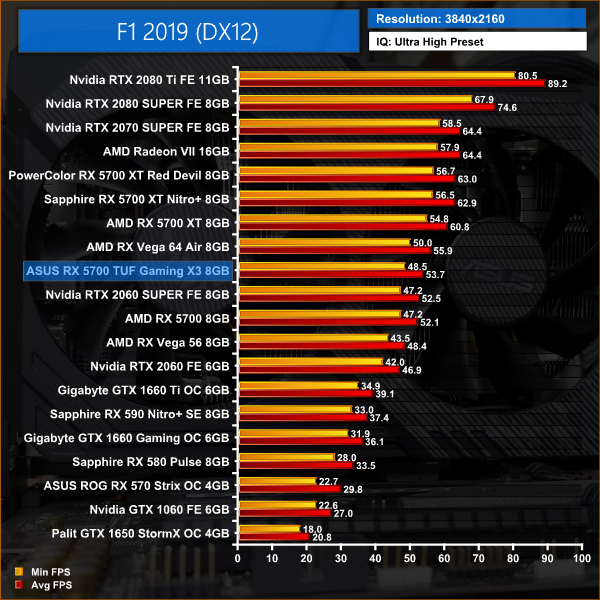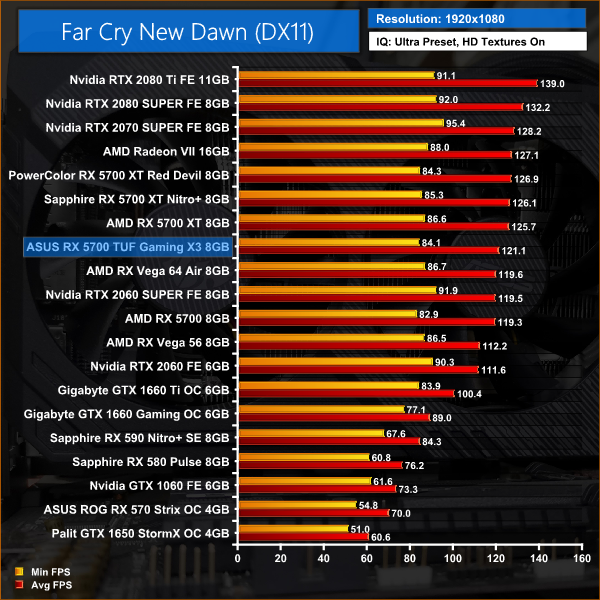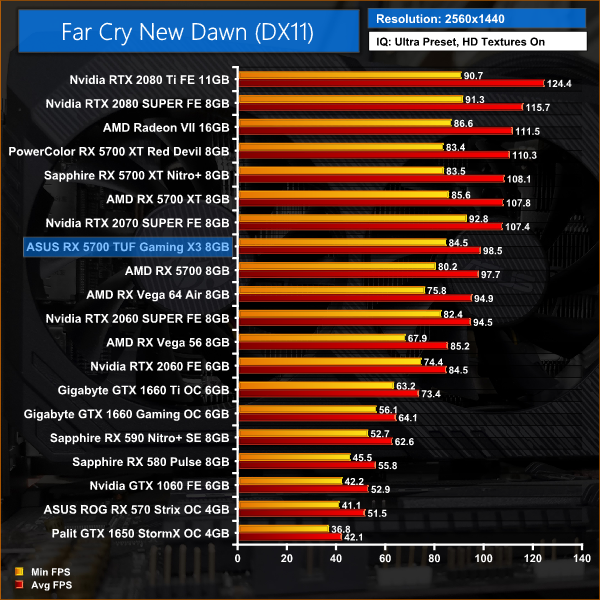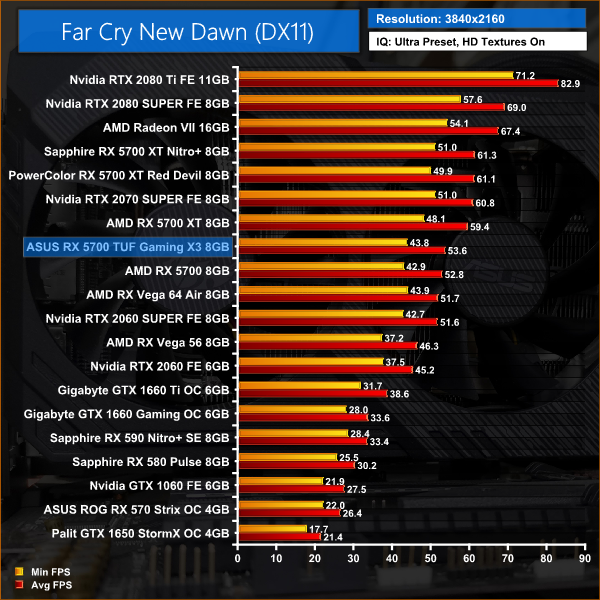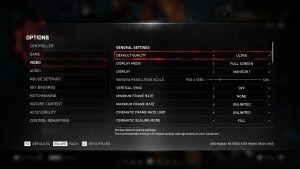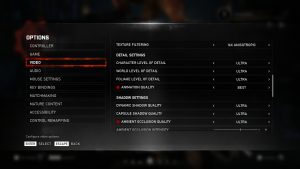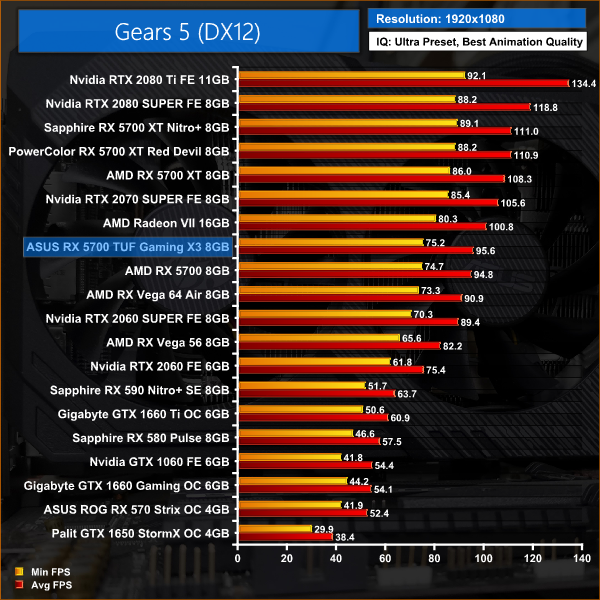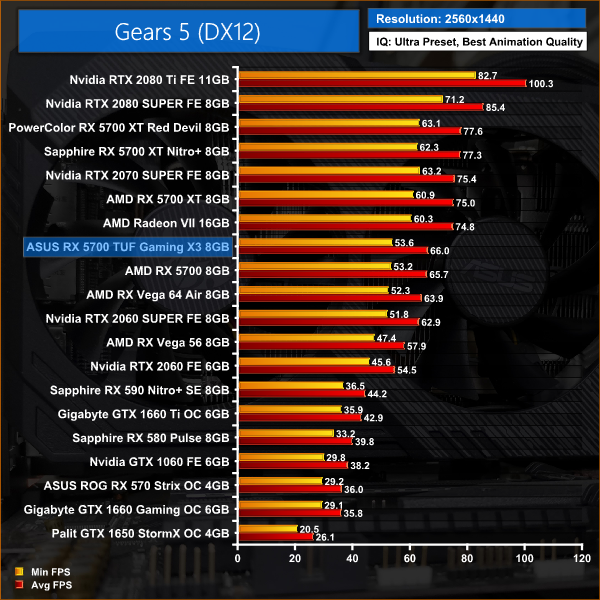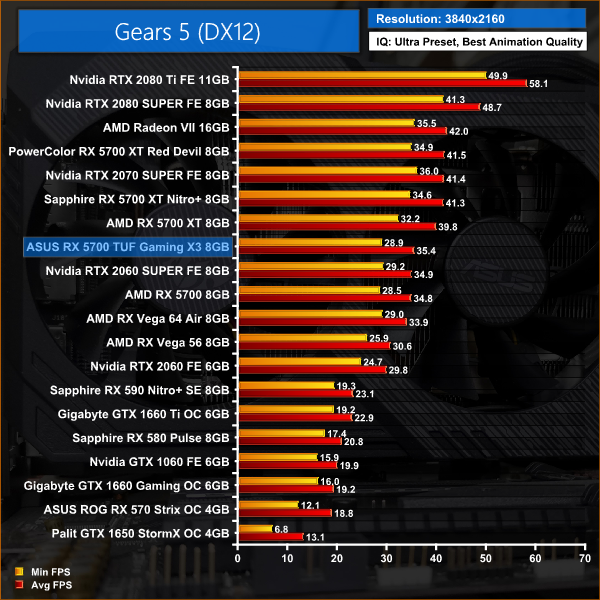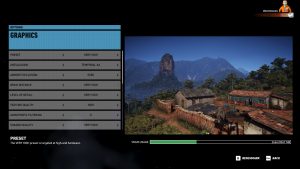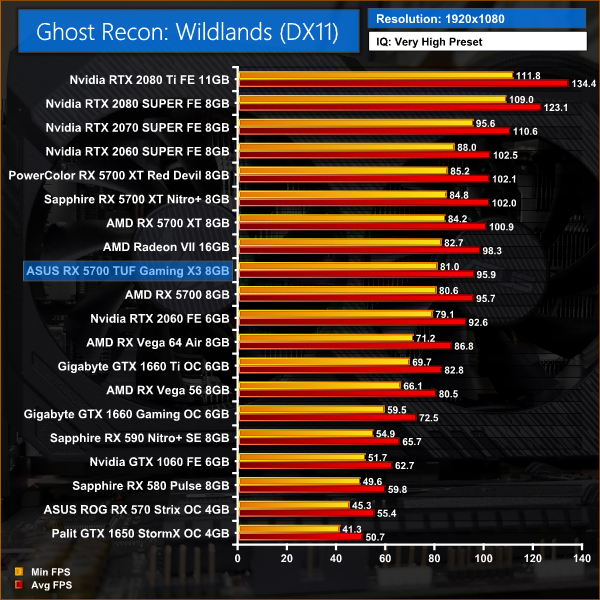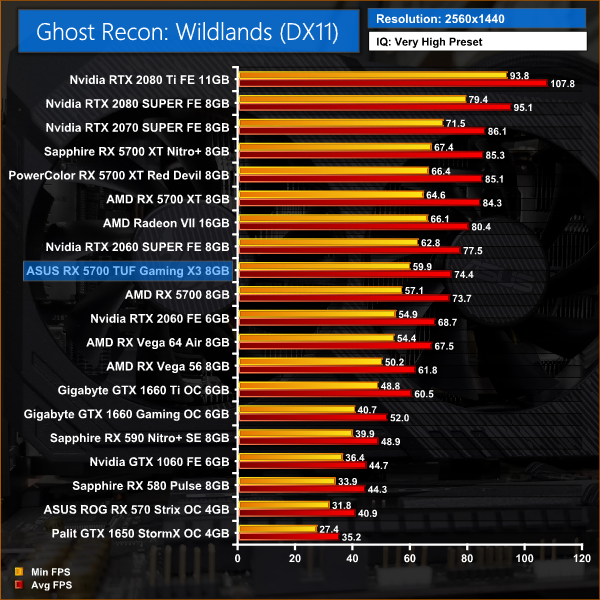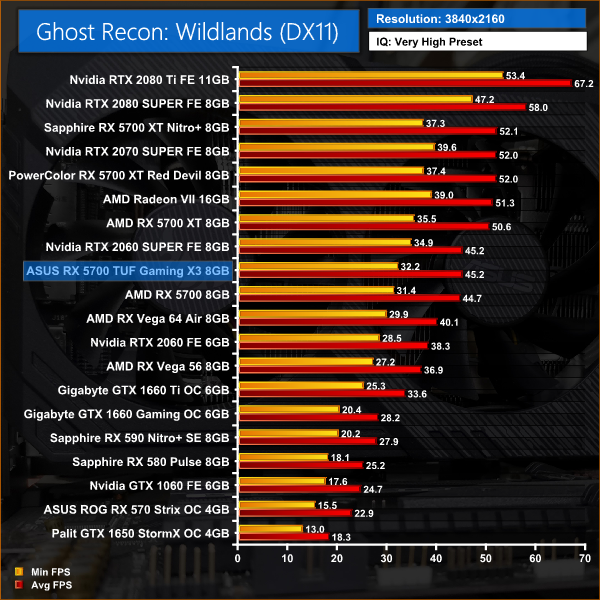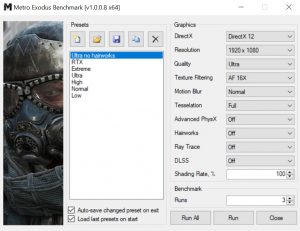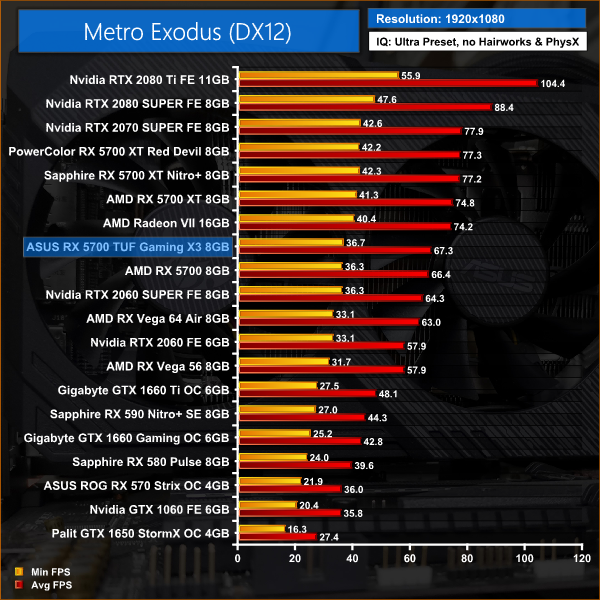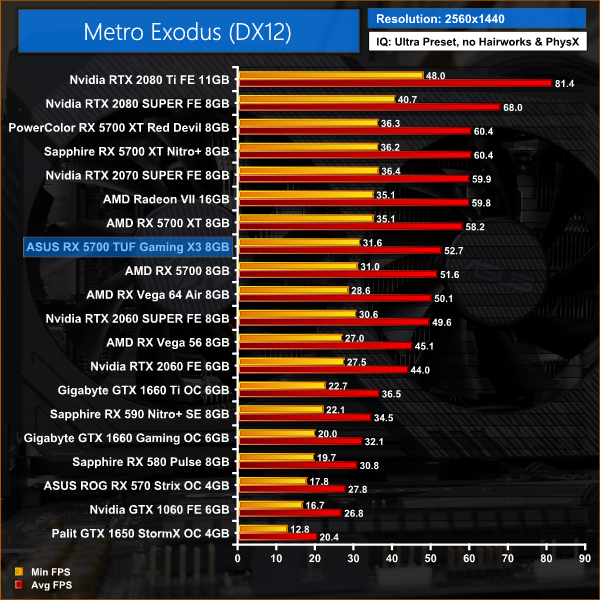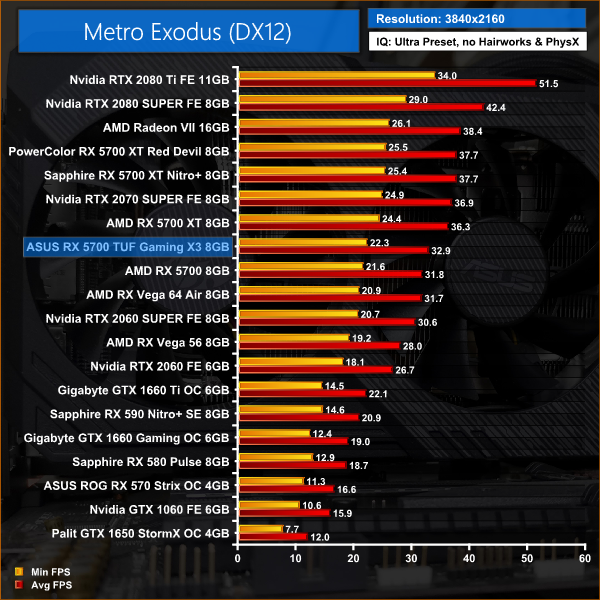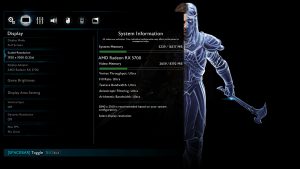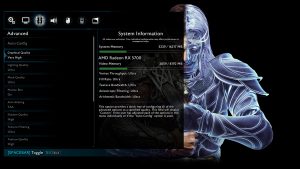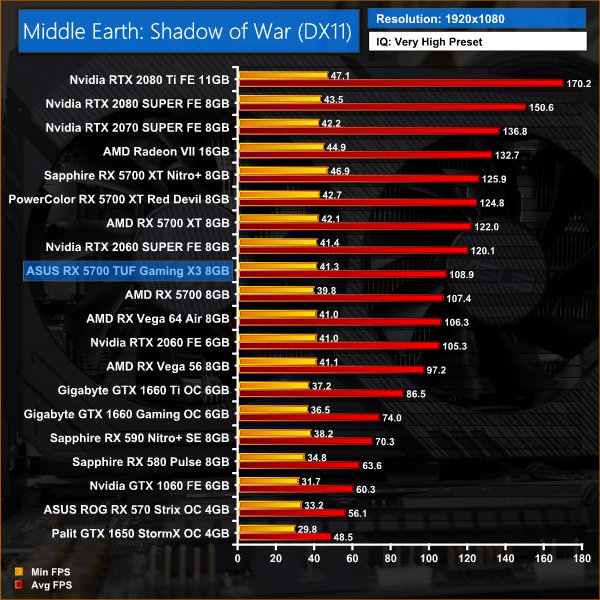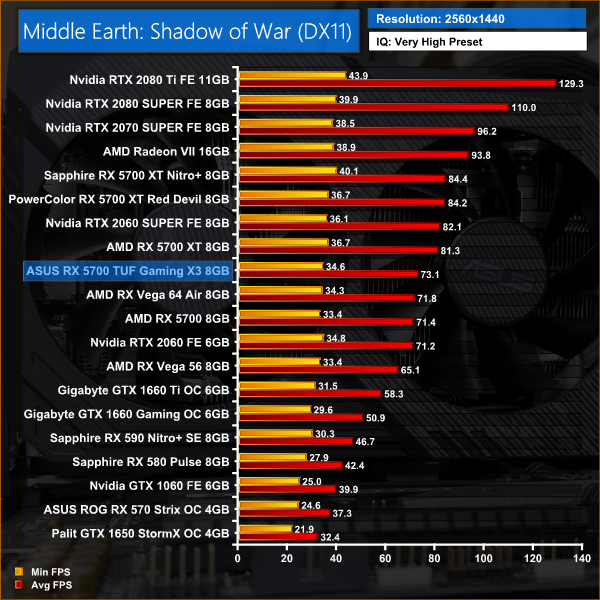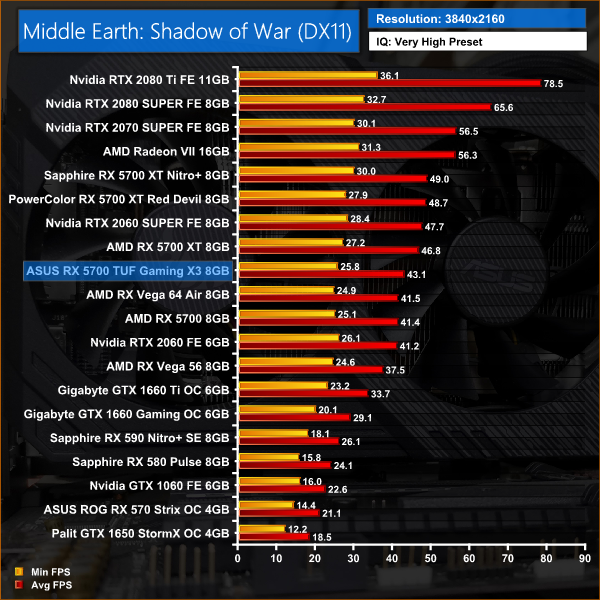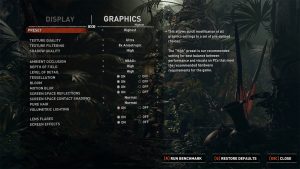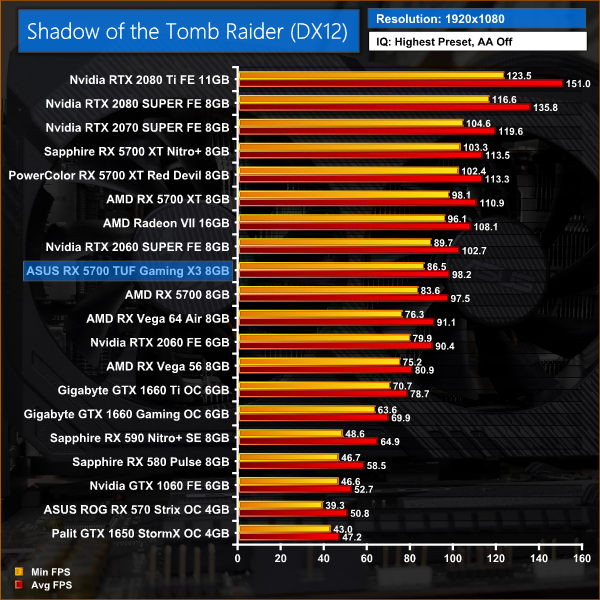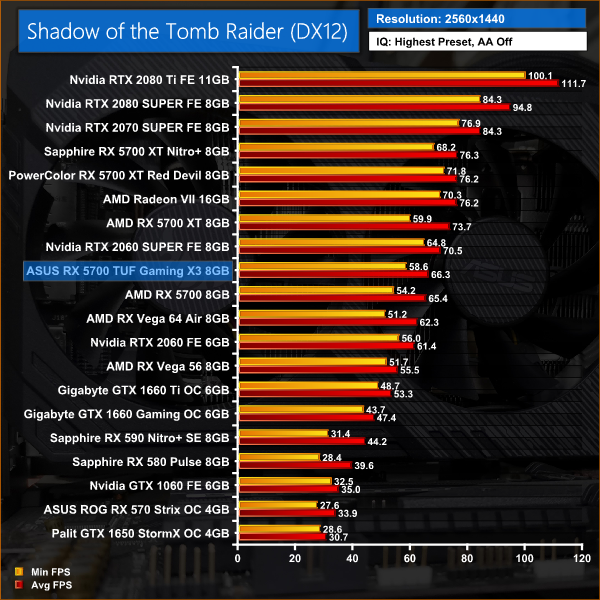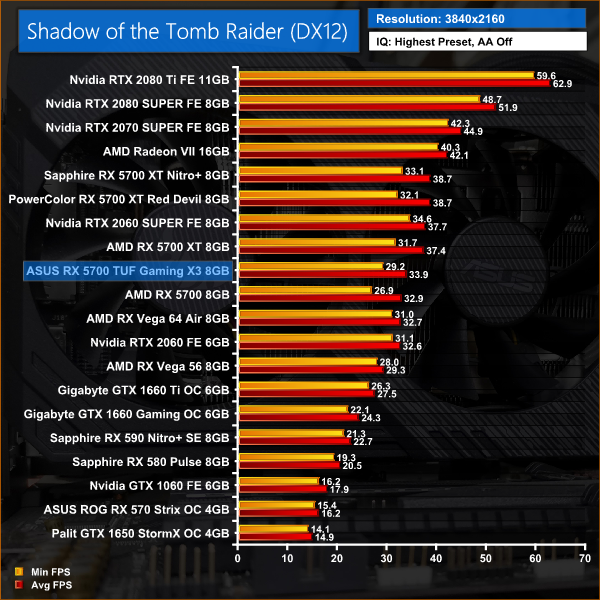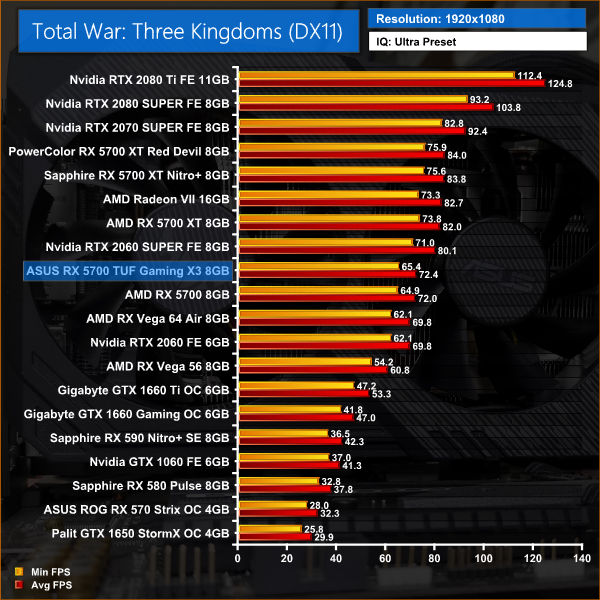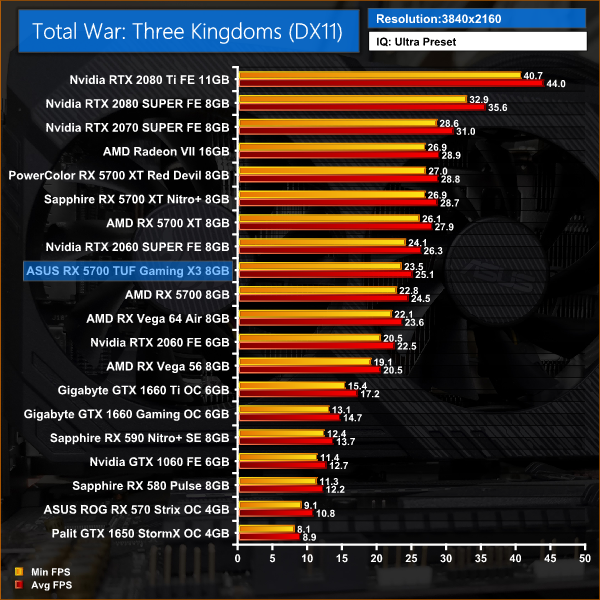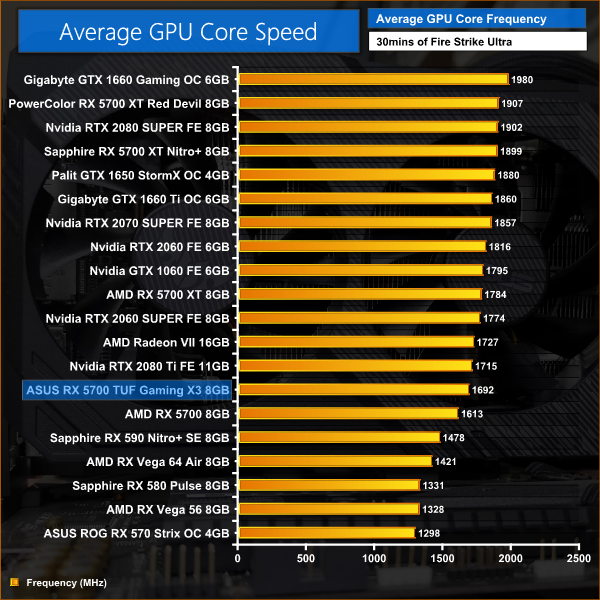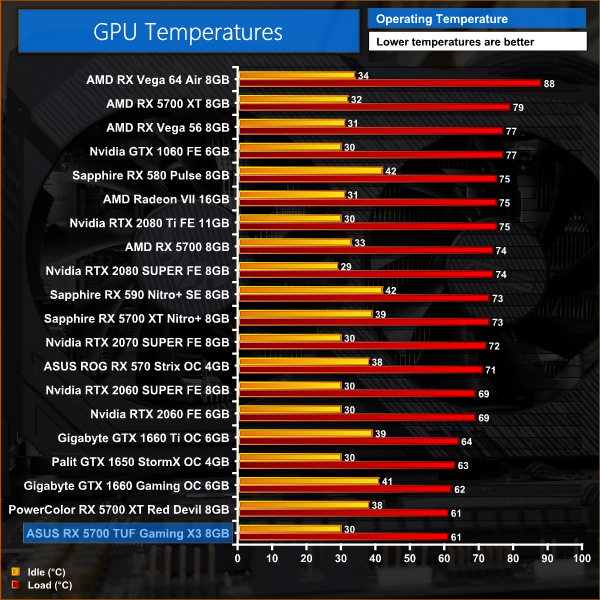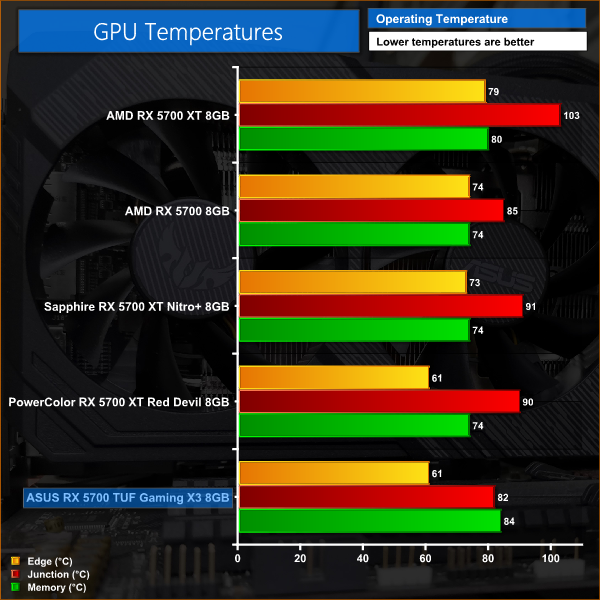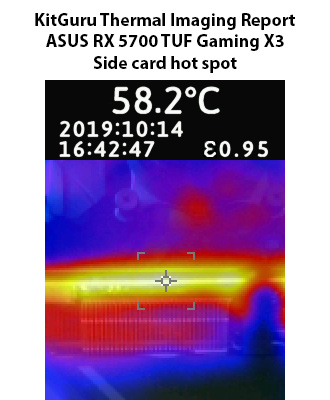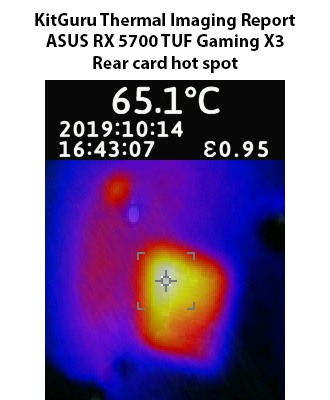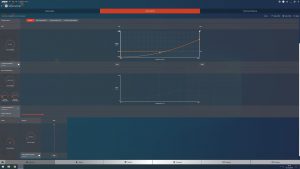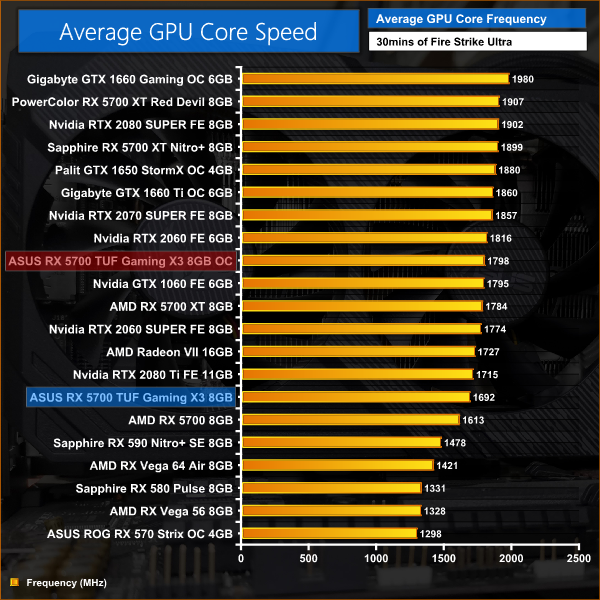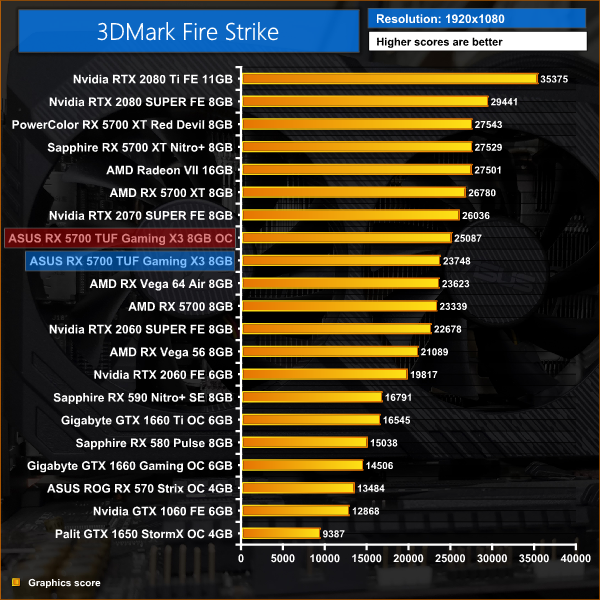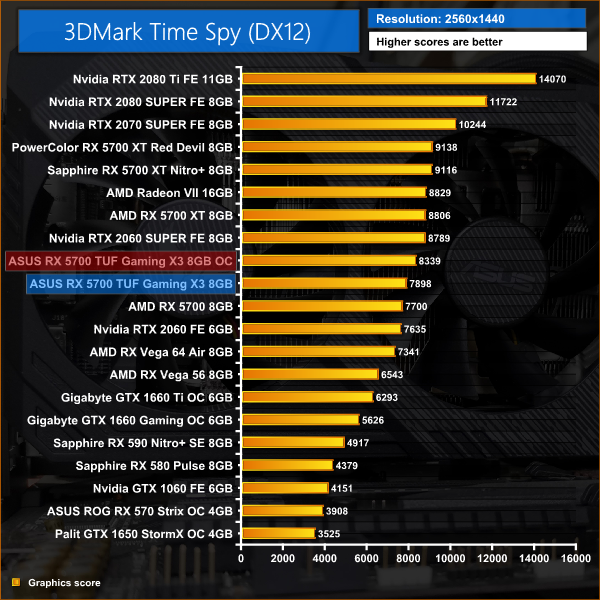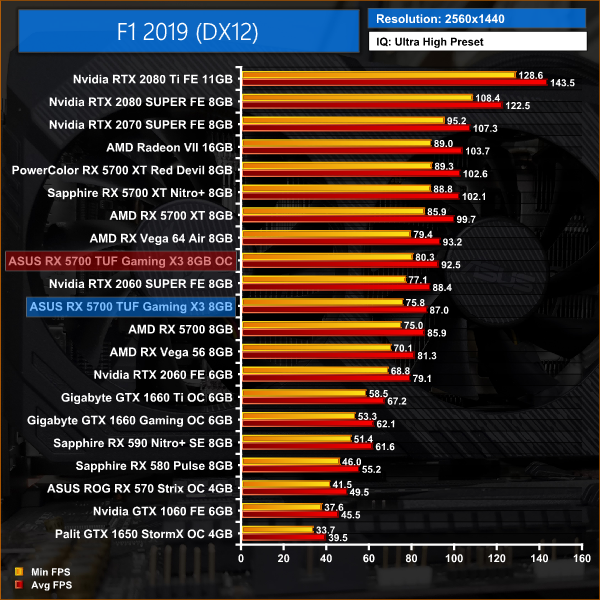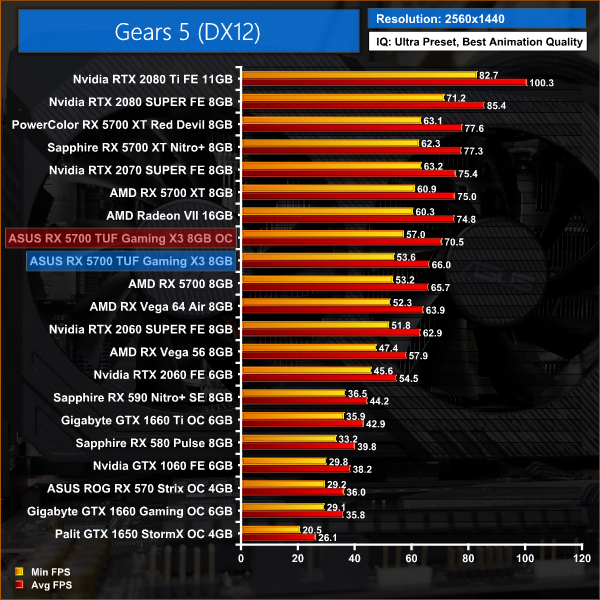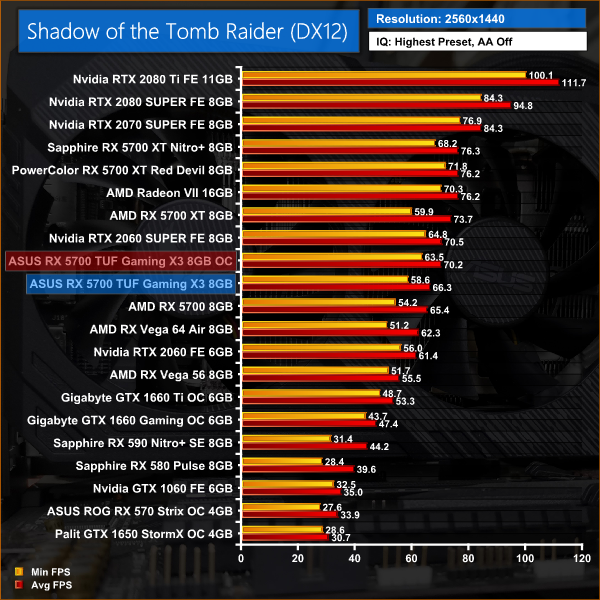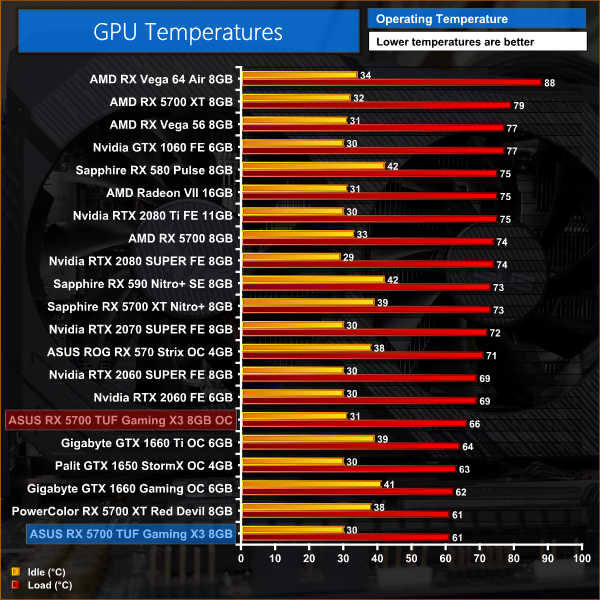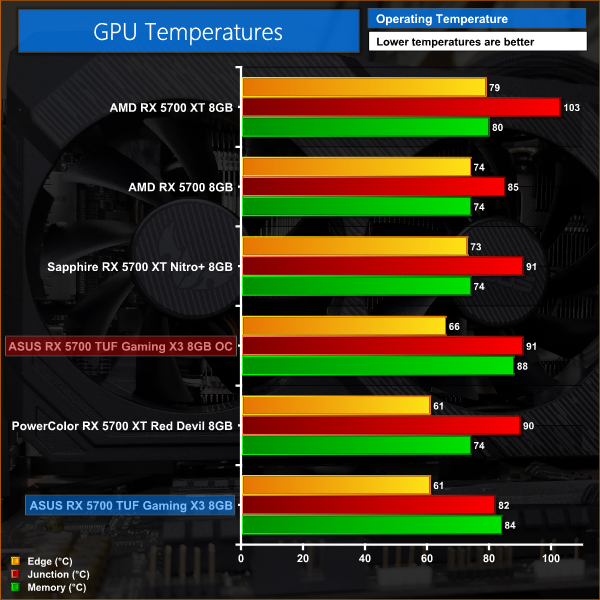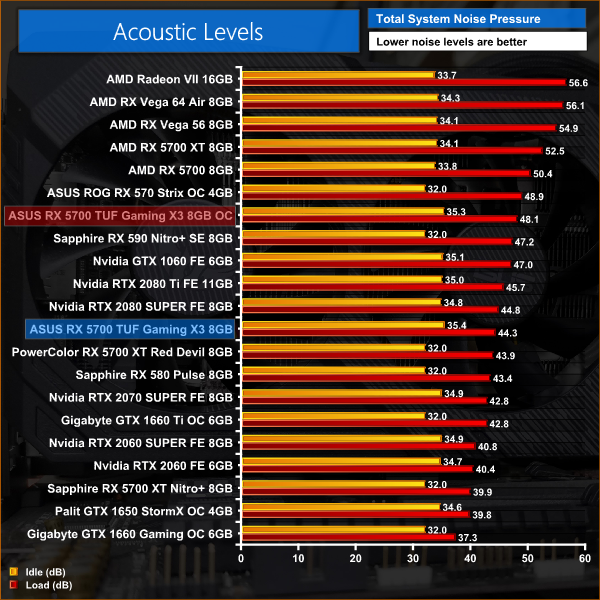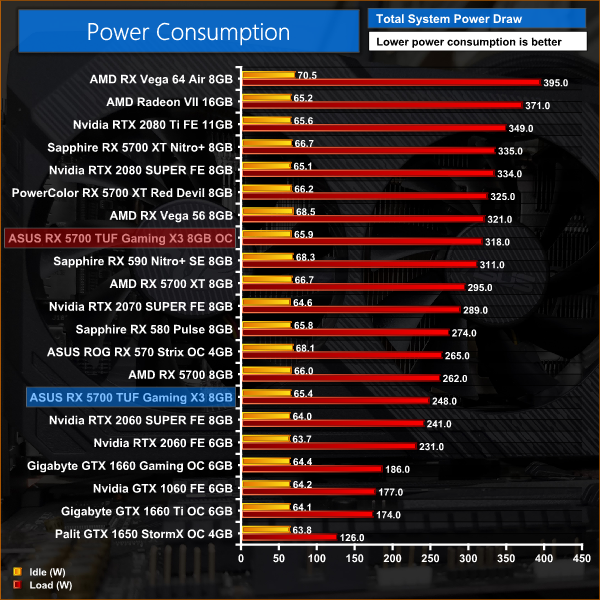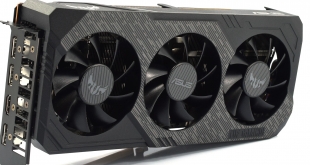
Since AMD launched its new Navi graphics cards back in July, a lot of focus has been given to the RX 5700 XT, with the baby brother RX 5700 receiving less attention. We are trying to change that today, however, with a look at ASUS' TUF Gaming X3 RX 5700 card. Featuring a smart black shroud, triple-fan cooler and factory overclocked core, is this the card to go for under £400?
As part of the ASUS TUF Gaming series, the company has made a few claims regarding the ‘tuf' nature of this new RX 5700. These include an 144-hour validation program, Auto-Extreme Technology which ‘uses automation to enhance reliability', and even ‘space-grade lubricant‘ for the dual ball bearing fans.
Pricing is also something to be aware of, with this card coming in at £379.99. That's £50 above the reference MSRP for RX 5700, putting close to RX 5700 XT territory.
| RX 5700 | RX 5700 XT | RX Vega 56 | RX Vega 64 | Radeon VII | |
| Architecture | Navi | Navi | Vega 10 | Vega 10 | Vega 20 |
| Manufacturing Process | 7nm | 7nm | 14nm | 14nm | 7nm |
| Transistor Count | 10.3 billion | 10.3 billion | 12.5 billion | 12.5 billion | 13.2 billion |
| Die Size | 251mm² | 251mm² | 486mm² | 495mm² | 331mm² |
| Compute Units | 36 | 40 | 56 | 64 | 60 |
| Stream Processors | 2304 | 2560 | 3584 | 4096 | 3840 |
| Base GPU Clock | Up to 1465MHz | Up to 1605MHz | 1156 MHz | 1274 MHz | 1400 MHz |
| Game GPU Clock | Up to 1625MHz | Up to 1755MHz | n/a | n/a | n/a |
| Boost GPU Clock | Up to 1725MHz | Up to 1905MHz | 1471 MHz | 1546 MHz | 1750 MHz |
| Peak Engine Clock | n/a | n/a | 1590 MHz | 1630 MHz | 1800 MHz |
| Peak SP Performance | Up to 7.95 TFLOPS | Up to 9.75 TFLOPS | Up to 10.5 TFLOPS | Up to 12.7 TFLOPS | Up to 14.2 TFLOPS |
| Peak Half Precision Performance | Up to 15.9 TFLOPS | Up to 19.5 TFLOPS | Up to 21.0 TFLOPS | Up to 25.3 TFLOPS | Up to 28.1 TFLOPS |
| Peak Texture Fill-Rate | Up to 248.4 GT/s | Up to 304.8 GT/s | Up to 330.0 GT/s | Up to 395.8 GT/s | 432.24 GT/s |
| ROPs | 64 | 64 | 64 | 64 | 64 |
| Peak Pixel Fill-Rate | Up to 110.4 GP/s | Up to 121.9 GP/s | Up to 94.0 GP/s | Up to 98.9 GP/s | 115.26 GP/s |
| Memory | 8GB GDDR6 | 8GB GDDR6 | 8GB HBM | 8GB HBM | 16GB HBM2 |
| Memory Bandwidth | 448 GB/s | 448 GB/s | 410 GB/s | 483.8 GB/s | 1 TB/s |
| Memory Interface | 256-bit | 256-bit | 2048-bit | 2048-bit | 4096-bit |
| Board Power | 185W | 225W | 210W | 295W | 300W |
ASUS has also pushed the clock speed of the RX 5700 a little further, with a rated ‘game clock' of 1720MHz, which is 95MHz faster than the reference card. There is the option to download ASUS GPU Tweak II and enable an ‘OC mode', but this only adds an extra 5MHz to the game clock and is an extra step required from the end-user.
Elsewhere, core spec of the RX 5700 means we have 36 Compute Units (CUs), with each CU housing 64 Stream Processors for a total of 2304. There's also 8GB of GDDR6 memory, clocked at 14Gbps, operating across a 256-bit bus, for 448GB/s total memory bandwidth.
The ASUS RX 5700 TUF Gaming X3 ships in a black box, with a medium-sized image of the card visible on the front, alongside the TUF and AMD Radeon branding.
Inside, the accessory bundle is limited – with just a quick start guide and thank you note included.
The card is what we are all here for though, and I do think it is an attractive design. The shroud is made from matt black plastic, but the section around the fans also features some grey lines/accents which look visually appealing. It's very colour neutral, so if you have a colour coordinated build, this won't cause you any problems.
Like I said, it is made from plastic – I do think an aluminium shroud would have suited the TUF brand perfectly, but inevitably that would also have lead to higher cost. As it is, the plastic shroud is surprisingly firm and hardly flexes at all – perhaps the overall square design helps with this, though once the card is installed in your case I suppose it doesn't matter too much either way.
Another thing to touch on are those three fans. They are Power Logic PLA08015S12HH models, measuring 80mm across (75mm blade to blade) so they're not the biggest fans. On top of that, the central hub is fairly large so the blades themselves aren't that long either. It will be interesting to look at thermals and acoustics later in the review.
Looking at both sides of the card, we can again see how the plastic shroud keeps its square design, extending a fair way up the sides of the heatsink.
It's also worth touching on dimensions, with the card measuring 269 x 125 x 54mm. So at just under 27cm it's not the longest card I've reviewed this year, but it's still a 2.7slot card so you will want three free expansion slots in your case.
On the front side of the card, we can get a look at the TUF logo on the left-hand side, and the ASUS logo over in the right corner. There's also a very small LED strip next to the TUF logo which lights up once the system is powered on.
As for the backplate, it's a full-length metal design, with just a small cut-out behind the GPU core. It's black with more grey accenting which personally I find quite stylish, but feel free to disagree with me.
For power requirements, the card has 1x 6-pin and 1x 8-pin connectors, while video outputs are provided by 3x DisplayPort and 1x HDMI connectors.
If we remove the cooler to get a look at the PCB, we can see ASUS has made a few changes here, with the GPU VRM being increased from a 6-phase design on the reference card, to an 8-phase design here. Memory power delivery is still handled by 2 phases.
Additionally, we can get a look at the 8x1GB GDDR6 memory modules from Micron, each chip is labelled ‘9LA77D9WCW'. The Navi 10 GPU is also visible, with its small 251mm² die size.
Now, as for the cooler, this uses two separate fin stacks which are connected by 4x 6mm heatpipes. These are nickel-plated apart from where the pipes make direct contact with the GPU die. Direct contact is unusual these days, with most manufacturers opting for a coldplate to contact with the GPU die.
Additionally, while there is a separate coldplate and thermal pad for the MOSFETs, I found it very surprising that there is no cooling for the VRAM chips at all – instead, the memory has to rely on airflow from the three fans instead of thermal pads and contact with a coldplate. This is certainly a strange move from ASUS – these Micron chips are rated at up to 95C so this is certainly something to look at later on.
Our newest GPU test procedure has been built with the intention of benchmarking high-end graphics cards. We test at 1920×1080 (1080p), 2560×1440 (1440p), and 3840×2160 (4K UHD) resolutions.
We try to test using the DX12 API if titles offer support. This gives us an interpretation into the graphics card performance hierarchy in the present time and the near future, when DX12 becomes more prevalent. After all, graphics cards of this expense may stay in a gamer’s system for a number of product generations/years before being upgraded.
We tested the RX Vega64 and Vega56 using the ‘Turbo‘ power mode in AMD’s WattMan software. This prioritises all-out performance over power efficiency, noise output, and lower thermals.
Driver Notes
- All AMD graphics cards were benchmarked with the Adrenalin 19.9.2 driver.
- All Nvidia graphics cards were benchmarked with the Nvidia 436.48 driver.
Test System
We test using the Overclockers UK Germanium pre-built system, though it has been re-housed into an open-air test bench. You can read more about it over HERE.
| CPU |
Intel Core i7-8700K
Overclocked to 5.0GHz |
| Motherboard |
ASUS ROG Strix Z370-F Gaming
|
| Memory |
Team Group Dark Hawk RGB
16GB (2x8GB) @ 3200MHz 16-18-18-38 |
| Graphics Card |
Varies
|
| System Drive |
Samsung 960 EVO 500GB
|
| Games Drive | Crucial M4 512GB |
| Chassis | Streacom ST-BC1 Bench |
| CPU Cooler |
OCUK TechLabs 240mm AIO
|
| Power Supply |
Corsair AX1500i 80+ Titanium PSU
|
| Operating System |
Windows 10 1903
|
Comparison Graphics Cards List
- Nvidia RTX 2080 Ti Founders Edition (FE) 11GB
- Nvidia RTX 2080 SUPER Founders Edition (FE) 8GB
- Nvidia RTX 2070 SUPER Founders Edition (FE) 8GB
- Nvidia RTX 2060 SUPER Founders Edition (FE) 8GB
- Nvidia RTX 2060 Founders Edition (FE) 6GB
- Gigabyte GTX 1660 Ti OC 6G
- Gigabyte GTX 1660 Gaming OC 6G
- Palit GTX 1650 StormX OC 4GB
- Nvidia GTX 1060 Founders Edition (FE) 6GB
- AMD RX 5700 XT 8GB
- PowerColor RX 5700 XT Red Devil 8GB
- Sapphire RX 5700 XT Nitro+ 8GB
- AMD RX 5700 8GB
- AMD Radeon VII 16GB
- AMD RX Vega 64 Air 8GB
- AMD RX Vega 56 8GB
- Sapphire RX 590 Nitro+ SE 8GB
- Sapphire RX 580 Pulse 8GB
- ASUS RX 570 ROG Strix Gaming OC 4GB
Software and Games List
- 3DMark Fire Strike & Fire Strike Ultra (DX11 Synthetic)
- 3DMark Time Spy (DX12 Synthetic)
- 3DMark Port Royal (DXR Synthetic)
- Battlefield V (DX12)
- The Division 2 (DX11)
- F1 2019 (DX12)
- Far Cry New Dawn (DX11)
- Gears 5 (DX12)
- Ghost Recon: Wildlands (DX11)
- Metro: Exodus (DX12)
- Middle Earth: Shadow of War (DX11)
- Shadow of the Tomb Raider (DX12)
- Total War: Three Kingdoms (DX11)
We run each benchmark/game three times, and present averages in our graphs.3DMark Fire Strike is a showcase DirectX 11 benchmark designed for today’s high-performance gaming PCs. It is our [FutureMark’s] most ambitious and technical benchmark ever, featuring real-time graphics rendered with detail and complexity far beyond what is found in other benchmarks and games today.
With a 95MHz clock speed advantage over the reference RX 5700, 3DMark translates this into 2 or 3% gains for the ASUS TUF Gaming card – 2% for Fire Strike, and 3% with Time Spy and Fire Strike Ultra.
Battlefield V is a first-person shooter video game developed by EA DICE and published by Electronic Arts. Battlefield V is the sixteenth instalment in the Battlefield series. It was released worldwide for Microsoft Windows, PlayStation 4, and Xbox One on November 20, 2018. (Wikipedia).
We test using the Ultra preset, DX12 API.
There's very little between this ASUS card and the reference design in Battlefield V, especially at 1080p where just 0.3FPS separates the two. The TUF Gaming does prove 2% faster at 4K, however.
Tom Clancy's The Division 2 is an online action role-playing video game developed by Massive Entertainment and published by Ubisoft. The sequel to Tom Clancy's The Division (2016), it is set in a near-future Washington, D.C. in the aftermath of a smallpox pandemic, and follows an agent of the Strategic Homeland Division as they try to rebuild the city. (Wikipedia).
We test using the Ultra preset, but with V-Sync disabled, DX11 API.
Things carry on in a similar vein with The Division 2, a new addition to our roster. Here, the TUF Gaming card proves 2% faster than reference at 1440p, which works out at less than a single frame.
F1 2019 is a racing video game based on the 2019 Formula One and Formula 2 Championships. The game is developed and published by Codemasters and is the twelfth title in the Formula One series developed by the studio. The game was announced by Codemasters on 28 March 2019. (Wikipedia).
We test using the Ultra High preset, with TAA and 16x Anisotropic Filtering, DX12 API.
Another new addition to our suite of games, F1 2019 sees a 2% performance advantage for the TUF Gaming X3 versus AMD's reference design.
Far Cry New Dawn is an action-adventure first-person shooter developed by Ubisoft Montreal and published by Ubisoft. The game is a spin-off of the Far Cry series and a narrative sequel to Far Cry 5. It was released for Microsoft Windows, PlayStation 4 and Xbox One on February 15, 2019. (Wikipedia).
We test using the Ultra preset, with the HD Textures pack, DX11 API.
More of the same here, with the TUF Gaming offering no more than 2% increase frame rates versus the reference card. At 1440p, the difference is just 1%.
Gears 5 is a third-person shooter video game developed by The Coalition and published by Xbox Game Studios for Microsoft Windows and Xbox One. It is the sixth instalment of the Gears of War series, and is the second Gears of War game not to be developed by Epic Games.
We test using the Ultra preset, with Best Animation Quality (instead of Auto), DX12 API.
Gears 5 is an AMD title and here we can see this ASUS RX 5700 with a 6FPS advantage over the 2060 SUPER at 1080p. AMD's reference RX 5700 is essentially on par with the TUF card here.
Tom Clancy’s Ghost Recon Wildlands is a tactical shooter video game developed by Ubisoft Paris and published by Ubisoft. It was released worldwide on March 7, 2017, for Microsoft Windows, PlayStation 4 and Xbox One, as the tenth instalment in the Tom Clancy’s Ghost Recon franchise and is the first game in the Ghost Recon series to feature an open world environment. (Wikipedia).
We test using the Very High preset, DX11 API.
Ghost Recon Wildlands shows some of the smallest differences between ASUS' factory overclocked card, and the stock-clocked reference design. At 1080p and 1440p, there's less than a single percentage point in it.
Metro Exodus is a first-person shooter video game developed by 4A Games and published by Deep Silver in 2019. It is the third instalment in the Metro video game series based on Dmitry Glukhovsky's novels, following the events of Metro 2033 and Metro: Last Light. (Wikipedia).
We test using the Ultra preset, but with Hairworks and Advanced PhysX turned off, DX12 API.
Metro Exodus is, perhaps surprisingly considering it was one of the first games with RTX support, another title which has RX 5700 a fair margin ahead of 2060 SUPER, with this ASUS card proving 6% faster at 1440p. The TUF Gaming X3 is 2% faster than the reference 5700 here.
Middle-earth: Shadow of War is an action role-playing video game developed by Monolith Productions and published by Warner Bros. Interactive Entertainment. It is the sequel to 2014’s Middle-earth: Shadow of Mordor, and was released worldwide for Microsoft Windows, PlayStation 4, and Xbox One on October 10, 2017. (Wikipedia).
We test using the Very High preset, DX11 API.
It's more of the same in Middle Earth: Shadow of War, though at 4K the TUF Gaming is 4% faster than the AMD reference design – that's the single biggest performance increase we saw across all of our games.
That said, versus the 2060 SUPER, Shadow of War hands this RX 5700 its biggest performance loss, with the AMD card 11% slower than the 2060 SUPER at 1440p.Shadow of the Tomb Raider is an action-adventure video game developed by Eidos Montréal in conjunction with Crystal Dynamics and published by Square Enix. It continues the narrative from the 2013 game Tomb Raider and its sequel Rise of the Tomb Raider, and is the twelfth mainline entry in the Tomb Raider series. The game released worldwide on 14 September 2018 for Microsoft Windows, PlayStation 4 and Xbox One. (Wikipedia).
We test using the Highest preset, with AA disabled, DX12 API.
Despite again falling behind 2060 SUPER in Shadow of the Tomb Raider, it's another 2% win for the TUF Gaming card when compared to the reference 5700.
Total War: Three Kingdoms is a turn-based strategy real-time tactics video game developed by Creative Assembly and published by Sega. As the 12th mainline entry (the 13th entry) in the Total War series, the game was released for Microsoft Windows on May 23, 2019.
We test using the Ultra preset, DX11 API.
Our last game on test is another new title, Total War: Three Kingdoms. This is typical of our testing today, with just 1-2% differences between reference RX 5700 and ASUS' card.
Here we present the average clock speed for each graphics card while running the 3DMark Fire Strike Ultra stress test for 30 minutes. We use GPU-Z to record the GPU core frequency during the Fire Strike Ultra runs. We calculate the average core frequency during the 30 minute run to present here.
Taken across our 30 minute stress test, the TUF Gaming X3 averaged 1692MHz. This is 5% faster than the reference card, which averaged 1613MHz. Our testing had the ASUS card 2% faster in games, so the frequency doesn't scale perfectly with in-game performance, but I guess it is better than nothing.
For our temperature testing, we measure the peak GPU core temperature under load, as well as the GPU temperature with the card idling on the desktop. A reading under load comes from running the 3DMark Fire Strike Ultra stress test for 30 minutes. An idle reading comes after leaving the system on the Windows desktop for 30 minutes.
Starting with our ‘big picture' look at temperatures, above we are focusing just on the ‘edge temperature' of the GPU, or the figure we know best as just ‘GPU temperature.' This paints a very rosy picture for the TUF Gaming X3, with a peak temperature of just 61C making this tied with the Red Devil for best thermal performance on our chart.
Looking closer, however, we can see that all is not well. Above we have five RX 5700/5700 XT cards on their own chart, with those cards also including built-in memory temperature sensors where AMD reports the maximum temperature of the hottest memory module through Wattman (and GPU-Z).
As you can see, the TUF Gaming X3's memory peaked a whole 10C hotter than the reference RX 5700. We mentioned at the start of this review how the lack of any kind of VRAM cooling was surprising, and it certainly shows based on this testing.
It's not just that it runs hotter under load, but as we will see on the next page, the card isn't as quiet as it could be due to the fact that the VRAM relies entirely on the fans' airflow for cooling. That also means the fans don't have a zero rpm mode, as otherwise there'd simply be no cooling for the memory chips.
To be clear, edge and junction temperatures are great, the heatsink and its 4 heatpipes are more than sufficient to cool the GPU core – it's the memory which has been entirely neglected here. Do bear in mind though, that GPU temperatures will always be higher if there is no VRAM cooling, as the heatsink isn't having to deal with the heat from the memory as well, so we would expect better GPU-only temperatures considering the lack of VRAM cooling.
Lastly, a look at our thermal images shows the card itself does not get that hot at all, peaking at 65.1C on the rear of the PCB. We take our noise measurements with the sound meter positioned 1 foot from the graphics card. I measured the noise floor to be 32 dBA, thus anything above this level can be attributed to the graphics cards. The power supply is passive for the entire power output range we tested all graphics cards in, while all CPU and system fans were disabled.
A reading under load comes from running the 3DMark Fire Strike Ultra stress test for 30 minutes. An idle reading comes after leaving the system on the Windows desktop for 30 minutes.
As for noise levels, I wouldn't describe the TUF Gaming X3 as a loud card, but it's certainly audible. Across our testing, the fans span up to 40%, or 1850rpm, producing a consistent 44db of noise which is comparable to a 2080 SUPER Founders Edition. So it's clearly audible without being annoyingly loud.
Given the low (61C) peak GPU temperature, if memory cooling was sufficient ASUS could easily afford to slow the fans down and have a quieter card that just runs a little hotter. Based on my testing, running the fans at 28%, or 1580rpm, reduced noise levels to 40dB while temperatures only increased to 66C edge and 86C junction – still excellent results.
That said, the GDDR6 memory is entirely reliant on airflow for cooling, so dropping the fans to 28% also saw memory temperature increase from 84C to 88C, and bear in mind these chips are rated up to 95C by Micron. Clearly, ASUS has cut corners with the memory cooling and paid the price with noise levels, as while this isn't a loud card, it is a lot more audible than it should be.
We measure system-wide power draw from the wall while the card is sat idling at the Windows 10 desktop for 30 minutes. A reading under load comes from running the 3DMark Fire Strike Ultra stress test for 30 minutes.
Interestingly, power draw for the overclocked TUF Gaming X3 RX 5700 is lower than the reference model. It could be ASUS' custom PCB design is simply more efficient, but our system pulled 14W less with the ASUS card than with AMD's reference design.
I have to say, overclocking the TUF Gaming X3 was surprisingly easy – definitely my easiest experience yet with a Navi card. I simply maximised the frequency/voltage slider, maximised the power limit and set the memory to its maximum frequency of 930MHz (14.88Gbps).
Average clock speed under load
This resulted in a real-world frequency gain of around 100MHz based on our 30 minute Fire Strike Ultra stress test run.
Games
This saw our frame rates increase by around 6% in the games we tested at 1440p, with our Fire Strike and Time Spy scores also increasing by the same margin.
Here, we take a further look at the impact of our overclock, looking at the increased temperatures, acoustics and power draw.
Temperatures
Acoustics
Power consumption
Overview
When running with this overclock, we saw an increase in GPU edge temperature from 61C to 66C, while junction temperature rose from 82C to 91C – though this is still 19C less than AMD's official maximum figure of 110C.
Fan speed also increased, from 1850rpm up to 2150rpm (46%), though that wasn't enough to keep memory temperatures rising another 4C, up to 88C. Still, 48dB is definitely getting quite loud so again we are suffering the consequences of the lack of VRAM cooling.
Lastly, power draw rose more than I was anticipating, with our system pulling an extra 70W with the GPU overclocked. It would really depend on your priorities (and electric prices) whether the 6% performance increase was worth this extra power.
Switching focus back to the little brother of the Navi duo, today we have reviewed the ASUS RX 5700 TUF Gaming X3. With a sleek shroud design and triple fan cooler, this card looked good on first impression, but one flaw stood out when we took a closer look.
Namely, that would be the memory cooling. Or, more accurately, the lack of memory cooling. Usually, a graphics card cooler will have a single coldplate which contacts the GPU die and memory (like the PowerColor Red Devil), or there might be a dedicated coldplate for the VRAM that transfers heat to the card's fin stack (per the Sapphire Pulse).
ASUS has not taken either of those approaches. Instead, the card relies solely on airflow from the three fans for the memory cooling, as there is simply nothing contacting the memory modules. Based on our testing, this resulted in a peak memory temperature increase of ten degrees Celsius versus AMD's reference RX 5700 card, with a reading of 84C. If we manually overclocked the memory, this rose to 88C, and do bear in mind that Micron rates the modules for operation up to 95C.
Technically, that is still in spec so it's not like I would expect the card to catch fire or stop working. That doesn't disguise the fact, however, that this is still a very poor thermal design from ASUS. The reference RX 5700 XT is still ‘in spec' with its junction temperature of 103C, but that doesn't mean it isn't a shoddy cooler, and the same goes here. When cards like the Sapphire Pulse exist, with proper VRAM cooling, you're settling for much worse memory temperatures with the TUF Gaming X3.
Cooling for the GPU itself is good, though admittedly this aided partly by the heatsink not having to deal with the heat from the memory, and also by the fact that the fans spin faster than they would otherwise need to if there was proper memory cooling. Still, we saw an edge temperature of 61C, and a junction temperature of 82C which are good results. The GPU also ran about 80MHz faster than the reference card, resulting in an extra 2% in-game performance.
That's all well and good – we wouldn't expect much more from even the fastest factory overclocked RX 5700 – but ASUS has also made life difficult for itself with the card's pricing. Coming in at £379.99 at Overclockers UK, this is actually the same price as PowerColor's dual-fan 5700 XT and only £20 less than Sapphire's 5700 XT Pulse.
The pricing alone would make it hard to recommend this card, but when you add in the lack of VRAM cooling, you do have to wonder what ASUS was thinking when designing the TUF Gaming X3. I really hope they can come up with a ‘revision 2' model which amends the heatsink design to incorporate the VRAM chips, but as things stand, when there are RX 5700 XT cards available for the same money, you would be best served looking elsewhere for your next graphics card.
We found the card for £379.99 at Overclockers UK HERE
Pros
- Sleek shroud design.
- Power draw slightly lower than reference RX 5700.
- Easy to overclock.
Cons
- Memory is cooled solely by airflow from the three fans, resulting in higher temperatures and noise levels.
- RX 5700 XT cards are available for the same money.
KitGuru says: With proper VRAM cooling, the TUF Gaming X3 could be a decent card, but either way it is too expensive for a RX 5700.
Be sure to check out our sponsors store EKWB here
 KitGuru KitGuru.net – Tech News | Hardware News | Hardware Reviews | IOS | Mobile | Gaming | Graphics Cards
KitGuru KitGuru.net – Tech News | Hardware News | Hardware Reviews | IOS | Mobile | Gaming | Graphics Cards



